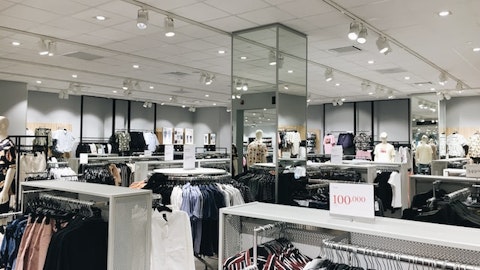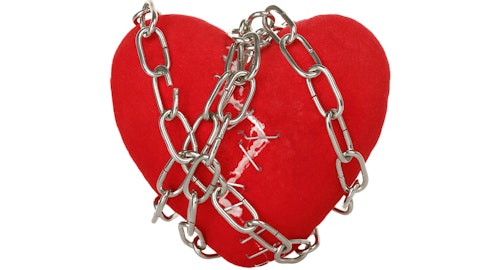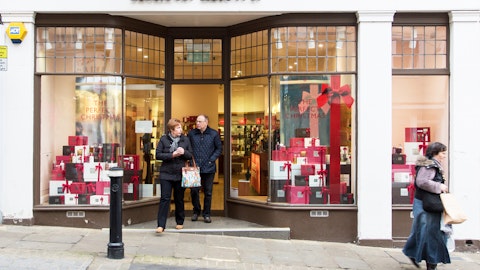That just – those can be a precursor for higher credit losses in the future. And so, we’re going to be mindful there and continue to watch it. And we do watch the portfolio closely. But as we said, I think our consumer tends to be a little bit more resilient, and so we’ll continue to watch that.
Brooke Roach: Great. Thanks so much. I’ll pass it on.
Operator: And next is from Dana Telsey with the Telsey Advisory Group. Please proceed.
Dana Telsey: Hi. Good afternoon everyone and welcome Cathy. Just following up on the credit for a moment. When you go back to the great financial crisis 2008, 2009, any parallels to learn of what happened then and what you’re seeing now? And then following up on the Rack business, and the new stores that you’re opening this year, how is new store productivity ramping versus what you may have expected or versus previous? And then just lastly, seeing what happening currently in the current environment. Any adjustments to plans for holiday, from what you’ve typically done in the past? Thank you.
Cathy Smith: Hi Dana, first off, great to see you or hear you again. So I appreciate that. Maybe I’ll start with credit. And if Erik wants to talk a little bit about rack productivity or I can and then maybe I’ll finish up with Pete on holiday, and how we’re doing that. So with regards to credit, you made me smile when you asked the question, because I lived through the financial crisis in a homebuilder. And to my very first question, to the team was tell me about how we performed in ’08, ’09 and ’10 as well. So may be smile that that’s where you went as well. And I would tell you, first off, for a lot of reasons, the business is a little different now than then we have a different arrangement with our credit card partner. We have a great partner there.
And so it is a little different arrangement. We continue to have a very strong credit quality in our portfolio as well. So for a lot of reasons, although our credit losses aren’t projected to be anywhere near where they were in the financial crisis, it’s a different book of business and a different arrangement. So, we feel very good about where we are and kind of how we’re projecting it. They have pretty good insights, because you do see the delinquencies coming. So feel like we’re in a good place there. And again, I’ll go back to the big picture, and that is they’re a really important part of our customer set. We – they typically are most engaged customers, so we’re really pleased with that. Maybe I’ll turn it over to Erik on Rack productivity of new stores and then Pete on holiday.
Erik Nordstrom: Yes. Hi Dana, we’re really pleased with our acne store performance and I’ll just scenery [ph] the importance of Rack new stores, first and foremost, is it’s a great return on our investment. And Rack new stores, the returns we’re getting out of those is very strong, well ahead of the cost of capital, and we’re encouraged by that.
Pete Nordstrom: Hi Dan, it’s Pete. With regards to holiday, in terms of changes from the past, I think the biggest thing is coming out of anniversary sales clean and having efficient inventory is super helpful. And we obviously have our plan, and it’s to continue to focus on the gifting target, but we also have some try powder so that whatever we’re able to learn here in the first couple of months to fall. We could invest back into holiday in terms of replenishment and a lot of those more kind of staple items that can help us a lot during the holiday season. So, I think we feel really good about the new things we’re able to invest in, and how we’re able to activate and energize the store and the shopping experience with making sure, that we’ve got the proper amount of money we can properly invest into the business for that time. So, we feel good about it.
Dana Telsey: Thank you.
Operator: And the next question is from Edward Yruma with Piper Sandler. Please proceed.
Edward Yruma: Hi good afternoon. Thanks for taking the question. Cathy, great to reconnect. I guess first on gross margin. I was wondering if you could unpack a little bit and kind of break out the impact of deleverage on lower sales versus lower markdowns versus last year? And how we should think about markdowns given the improved inventory level going forward? And then just as a follow-up, obviously, lots of discussion about shrink. We all saw the video would happen to [Topanga]. Just trying to understand how you see shrink play out for the remainder of the year? Thank you.
Cathy Smith: Hi Ed. So good to hear you again and look forward to seeing you live at some point. On gross margin, all impact that a little bit. And then maybe I’ll ask Erik to comment on shrinking stuff. As I know it’s been a topic with many retailers. But starting with gross margin to your question on deleveraging of sales, that absolutely has an impact, as you think about for the quarter, always does. Overall, though, with our – the continued work of the team, we were down gross margin only 20 basis points on the deleveraging of the sales, partially offset by a little bit of lower building and occupancy costs, so – or buying and occupancy cost. So generally, I would feel really good about gross margin. As we think about going forward, though, for gross margin, Q3.
You’re going to see – continue to see that the supply chain productivity for EBIT, which obviously don’t show up in gross margin as much. A little bit of sales deleverage. But then going into the back quarter or the fourth quarter, last year, remember, we had a lot of inventory that we bought through and marked down. We’re not going to see that same level or not planning to this year, given the quality or the health of our inventory going into the back half. So I think, overall, we feel really good about being able to focus on the things we can control, no matter what the consumer environment provides. Maybe, Erik, you could talk a little bit about shrink.
Erik Nordstrom: Yes, sure. Let me start with just the safety of employees and customers is always a top priority. Certainly, what happened in our [Topanga] store is disturbing to all of us. But the loss is a concern. Losses from factor at historical highs. And I’d say we find it unacceptable and needs to be addressed. That being said, while it’s unacceptable, it is within our plans. We have not seen continuing rising of shrinkage that has exceeded what we planned. So it’s in line with how we lead out this year. But the drag on earnings, just from a financial performance, that needs to come down. And we’ve done a lot of things, and we’re looking at everything we can do to make our stores safe and secure, first of all that they can be, but also to address the loss.
And there’s things within our control that we can invest in, but also involves partnering with local jurisdictions, law enforcement. I think the legislation is part of the mix to here that all industry needs to come to some of the better solutions on.
Edward Yruma: Thank you.
Operator: Next is from Blake Anderson with Jefferies. Please proceed.
Blake Anderson: Hi. Good afternoon. I wanted to start with Nordstrom Rack. Can you talk about kind of what inning are we now for getting the top brands back to normal in terms of the mix? I think you’re pretty close, but just wanted to ask about that? And then just more broadly on newness, how did that trend throughout the quarter? And how are you planning on newness for the back half?




